Florida Foraging 101
August 9th, 2007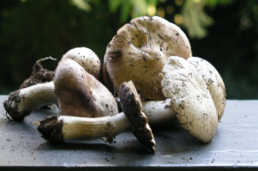
We’re not new to foraging. Back in Connecticut, we found (but kept silent about) a few neighborhood glens where mushrooms spring up after an autumnal rain. At first, we found mostly puffballs and campesters (the wild version of the button mushrooms in every supermarket). Once in a while we collected something that looked like porcini (aka boletus edulis), but were not always 100% sure. And because the margin of error in mushroom identification is slim, we had our share of anxiety until we bought a graphically precise mushroom field guide and met a veteran forager (who, thanks to his Polish DNA, is programmed to hunt for fungi after Labor Day). Soon enough, we were gathering enough mushrooms for a proper dish of pasta alla boscaiola, woodsman’s-style pasta. It was delicious. We felt we had put the ‘bosca’ back in boscaiola.
But since we’ve lived in Sarasota, we’ve been more mycologically challenged. We showed a couple of specimens to a friend who works at Selby Gardens. He studied our find through his loupe and muttered something about pores rather than gills without making a judgement; this did little to bolster our confidence. Needless to say, we changed our dinner plans.
Our fruit foraging has been more productive. Unlike virtually all our neighbors, we don’t own a dog. But whenever we go out for an evening stroll we bring a plastic bag, just in case something delicious has tumbled down to the side of the street. Surinam cherries, loquats, white sapote, calomondins…all edible—and ignored—in our vegetation-blessed neighborhood. Our only competition for this bounty are the local squirrels and less savory fruit rats. Beating them at their game adds a certain frisson to an already pleasant walk.
Certainly oranges have been easy enough to acquire. Even though our own back yard is home to several citrus trees, we do supplement our harvest with occasional evening forays. This is often necessary because the squirrels awaken before us and seem to enjoy starting their day with fresh OJ as much as we do.
One member of this partnership has proposed a rodent resettlement initiative. This would involve a couple of Haveahart traps and an evening drive “out east of I-75.” The plan has not gained unanimous support in our household legislature, so the proposal may have to be reintroduced during the fall fruit session; in any event, our next crop of oranges won’t ripen until November.
On the other hand, grapefruit are abundant for two reasons: 1) Most grapefruit are too large to be hauled off even by the most optimistic squirrel, and 2) half of Sarasota seems to be on Lipitor ®, for which grapefruit consumption is contraindicated.
If you follow food trends, you know that Alice Waters and her chefs at Chez Panisse have put the Meyer lemon on a culinary pedestal. It’s with good reason that this exceptionally juicy and fragrant citrus of low acidity is so prized, and we were thrilled to discover an old Meyer lemon tree on one of our trade routes. On the edge of a lot where a house was to be leveled, it was laden with fruit last year. We were looking forward to another lemon season, and it never occcured to us that after knocking over the house, the developer would also bulldoze every tree on the property! We’re still in mourning.
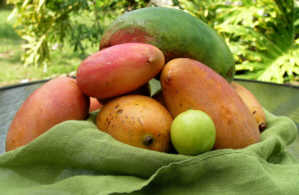
Mango season is in full swing now, and again, we’re astounded that so much fruit is simply lying on the ground. We found one mango that weighed nearly three pounds and dozens of others in the 14-oz. range. Here again, we are in competition with local wildlife. But caveat, fellow foragers! We won’t gorge ourselves on mangoes the way we did last year. One of us is allergic to poison ivy and found that excessive mango intake can trigger an itchy rash—not as discomfitting as poison ivy—but enough to make us look up the botanical family of Anacardiaceae, whose members include cashew, poison ivy, and…mangoes.
Exercising some restraint, we’ve been enjoying mangoes as a simple breakfast salsa. We wash our mangoes and then skin them with a carrot-peeler. We then rinse both the fruit and our hands—the resin from the skin contains most of the chemical allergens. Having cut the flesh into small chunks, we mix it with a little salt, freshly milled black pepper, red pepper flakes, juice from foraged limes, and coarsely chopped Thai basil. That, with some whole-grain toast, is a beautiful breakfast. We sometimes add grated ginger root and lime rind—but the mangoes are so delicious right now that we don’t have to do much.
Jazz at the Airport
August 8th, 2007Sarasota-Bradenton Airport: a Tuesday in August, 11 a.m. The temperature on the tarmac is 94 F. and rising. But inside the arrivals hall there’s a buzz—and it’s coming from something much cooler than air conditioning. For the month of August, arriving passengers (and those waiting to meet them) will be soothed by some of the finest jazz on the Gulf Coast.
Non-aeronautic diversions are nothing new for airports: bookstores, shoe-shine stands, 15-minute massage therapists… SRQ’s stars are swimmers, Mote Marine’s live leopard sharks. But now, the sharks have competition.
Bradenton Area Convention & Visitors Bureau executive director, Larry White is a big jazz fan. So big he has included the cavernous spaces of SRQ as a venue for the Bureau’s “Jazz on the Islands” series.
Twice each day through the entire month of August, from 11:00 a.m.—1:00 p.m. and from 3:30 p.m.—5:30 p.m., incoming passengers will be surprised to hear live jazz played by some of Sarasota’s most sophisticated musicians.
While it’s not yet apparent exactly how airport jazz is being received (a lot of arriving passengers come through talking on their cell phones), we gleaned the following comments between Tom Carabasi’s driving samba beats: “…a lot better than Fort Myers,” and “this place [SRQ] is a country club compared to Tampa.”
Dean of Sarasota jazz pianists and program coordinator, Michael Royal, has enlisted a Who’s Who of local performers. Rick Peterson, Tom Carabasi, Marc Mannino, Mark Neuenschwander, and Gary Goetz will rotate throughout the month, goodwill ambassadors for both arriving and departing passengers. Meanwhile, we defy anyone to find more mellow TSA agents than those at SRQ.
As we get farther into the rainy season here, sudden downpours can douse even the hottest outdoor concerts. So it’s exciting that Larry White’s creative, out-of-the-box thinking has tapped two of our great resources: a pool of extremely talented musicians and our superlative (and underutilized) airport.
Now, let’s figure out a way to perpetuate the program so that high-season travelers can also experience the theraputic benefits of jazz on the concourse.
Sipping at Short-Stop
August 4th, 2007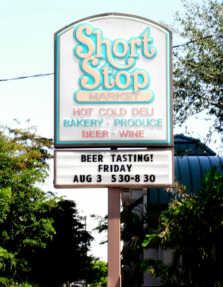
Just a quick note about the unexpected pleasures of a stout and ale tasting at the Short-Stop on Orange Avenue. It may be hard to imagine having an organized tasting of anything more sophisticated than beef jerky at a convenience store. But this is no ordinary convenience store.
The formerly generic, quick-in-and-out Short-Stop now devotes half its floor space to wine, including some very prestigious labels. The beer selection has grown far beyond long-necked Buds. Owner Ali Molavi, has taken his enterprise in new directions and has started to host monthly tastings. Last night, distributor J.J. Taylor was pouring seven distinctive specialty beers.
Though many beer aficionados lack the verbosity of wine tasters, mention of soy, peanut, smoke, espresso and citrus notes were heard. Vocabulary is fostered by connoisseurship, and we think any effort that makes us think about what we eat and drink is good.
The sampling included Wolaver’s Organic Brown Ale from Vermont and Brooklyn Pennant Ale. We were especially taken with the extremely hoppy Two-Heart Ale and the dense, bitter chocolate qualities of Kalamazoo Stout—both from Bell’s of Kalamazoo, Michigan.
Of course, if you want a long-necked Bud and some beef jerky, you can still find them here.
521 South Orange Avenue
Sarasota, Florida
941.955.6881
Sunday Morning at the Red Barn
July 29th, 2007Three years ago the gift of a five-gallon pot of basil from a Moroccan friend piqued our interest in shopping north of the county line. We asked where he had found such a robust plant. “Redbarn,” he muttered, as if that were a password to the Casbah.
We’d heard about the Red Barn, of course, but thought it to be merely a flea market. We learned otherwise. Having figured out the counter-intuitive turns from Rt. 301 and the dog-leg at Mel’s Diner, we’ve been visiting the Red Barn at least once a week ever since.
Ten miles north of downtown Sarasota, just past the Tropicana plant in Bradenton, the Red Barn is primarily an indoor flea market: acres of parking surround a sprawling single-storey red frame “barn” flanked to the north and east by approximately one hundred yards of bustling stalls selling mounds of fresh local and exotic produce.

Since most of the vendors are Mexican, the spirit, scents, and scene are a long way from the shrink-wrapped produce aisle of your local supermarket. It’s a quick tropical escape, a Diego Riviera painting. Step into the tableau, preferably wearing mud-shoes. English is fine, but junior-year Spanish is welcomed with a smile. Bring a market bag and small bills (cash is the only currency). Ten bucks buys a week’s worth of produce and fruit for a family of four.
On our latest visit, we find hundreds of boxes of Ruskin tomatoes and myriad varieties of peppers —a visual Scoville index—aglow beneath the vendors’ tents. We see ten-ounce green bell peppers for stuffing, chartreuse cubanelles, emerald serranos, red jalapeños and orange Scotch bonnets. And then there are the dried peppers—chipotles, guajiras, and a dozen more.
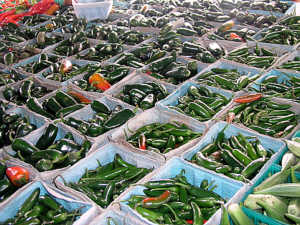
Other Florida offerings include huge smooth-skinned avocados, mild white onions, a range of citrus—from kumquats and Key limes to red navels and pomelos. For those whose cooking runs south of the border, there are tomatillos, cilantro, epazote, cactus paddles, dried corn husks, and even verdolaga (purslane, a succulent salad green in the portulaca family).
Bewildered by malanga, yucca, jicama, and kalalu? Stick with the crimson beets, red potatoes, lavender Asian eggplants, white daikon, and pyramids of radishes whose greens are as delicious as their bulbs. Generous bunches of dill, mint, thyme and parsley please the Middle Eastern, East Asian, and Slavic shoppers who come for the conviviality and great prices.
The open-air market also includes carnival-style hucksters selling dubious items like Cajun jerky and miracle carrot peelers. Inside, there is sausage vendor whose dour stall replicates Cold War Hungary. But these are stories for another time.
Almost 10 a.m., we’re hungry and head inside to Maria’s (open every day but Monday). The decals on the window say Tacos, Gorditas, Sopes, Menudo.
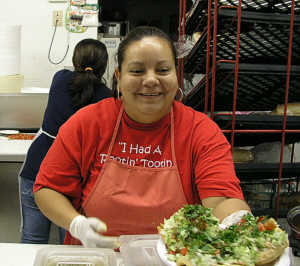
The place is spotless, the staff busy, the line outside the window long. The clientele—in Sunday-best cowboy boots, frilly dresses, or perhaps a Bucaneer baseball cap—knows this the THE place for carnitas, tripe tacos and the most savory salsa de aguacate in Manatee County.
From May to October, the full market is open 8 AM to 4 PM Friday, Saturday, and Sunday.



